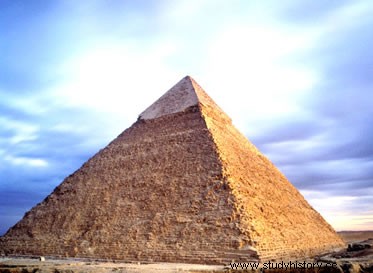
By Rainer Sousa
Of all the wonders of antiquity, the Great Pyramid of Giza, located in Egypt, is the only one that can still be seen by tourists today. As proof of the veneration that the Egyptians had for the pharaoh, this monument questions many of the prejudices that usually link the Ancient World to the ideas of “simplicity” and “incipience”. Built around 2550 BC, the sumptuous 137-meter-high monument was the work of 100,000 men over 20 years.
The Great Pyramid, in fact, makes up a set of constructions that name the so-called Pyramids of Giza. Since she alone was recognized as a marvel, it was a work commissioned by the pharaoh Cheops, who intended to use that grandiose project to house his sarcophagus and all the other gems that he should have carried in his other existence. Until the construction of the Eiffel Tower, in the 19th century, the pyramid of this pharaoh held the post of tallest construction in the world.
One of the unresolved mysteries about the pyramid of Giza concerns its own construction. How did the Egyptians lift those heavy blocks of stone that, on average, weighed about three tons? To answer this question, scientists work with two theories. The first suggests that each stone was moved using boats along the Nile River. Another theory is that the blocks were built by the Egyptians themselves using a type of cement.
In order for the stones to be fitted together, three possibilities are believed to explain the handling of stones in construction. A first theory says that the blocks were dragged through a ramp near the base of the pyramid. Another explanation works with the hypothesis that the outer walls of the pyramid had ramps that took the blocks to the highest parts. Recently, the architect Jean-Paul Houdini considered that the higher blocks had been loaded with internal ramps.
Knowledge about the internal structure of the Great Pyramid still stuns many researchers and Egyptologists fascinated by the object. To date, only three chambers have been discovered inside the building:the Royal Chamber, which housed the pharaoh's remains; the Chamber of Secrets; and the Queen's Chamber. To discover other compartments in the pyramid, scientists would have to be forced to use explosives that could compromise the structure of the pyramid.
Among other peculiarities, we can also mention that the Great Pyramid of Giza was originally entirely covered with polished limestone. This finish gave a “visual effect” to the construction of the pharaoh Cheops:the pyramid glowed when exposed to the sun. Unfortunately, much of the glossy coating was stolen over 600 years ago. In addition, the builders created several useless chambers and corridors to hinder a possible looting of the pharaoh's goods.
To ensure that the pharaoh's every whim was duly met during the execution of the project, there was a body of staff assigned to look after the resources and workers connected with the tomb. According to some historians, the process of building the pyramid not only reaffirmed the pharaoh's political-religious supremacy, but also served to mobilize several individuals who lived in different regions of Egypt.
